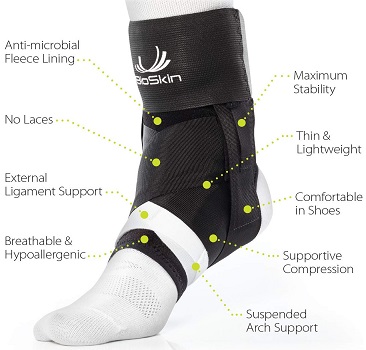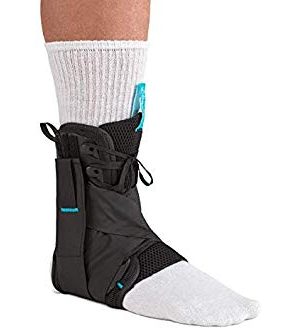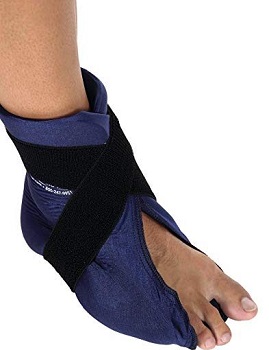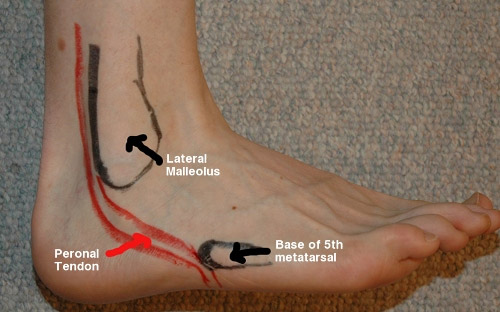Peroneal tendonitis is a condition that will be acute or chronic (peroneal tendinopathy) whereby there’s an irritation on peroneal tendons with subsequent degeneration and inflammation. Peroneal tendonitis could be a common reason behind pain around the back and outside of the foot. Treatment includes the RICE Protocol and anti-inflammatory medications, peroneal tendonitis ankle brace, massage, physical therapy, and stretches and strengthening exercises for the foot and calf muscles.
The peroneal tendons are robust, cord-like structures that link the peroneal muscles of the calf to the bones of the foot. Tendonitis happens once micro-tears cause tendon injury and inflammation, resulting in pain and difficulty walking.
Peroneal tendon injuries are typically for increased loads and overuse of the peroneal muscles. Over time, the tendon becomes thickened to manage the increase in a tensile load more effectively. Corresponding to American Family Physician, when tendonitis happens, individuals typically experience pain and swelling around the back and outside of the foot. Other symptoms embody popping and therefore the feeling of ankle joint instability.
The pain is sometimes worse with activity, comes on slowly, and gets more and worse over time. The foremost common reason for peroneal tendonitis is overuse. This injury is common in runners and other athletes whose sports need repetitive motion of the ankle joint or foot.
Peroneal Tendonitis presents a sharp pain on the length of the tendons or the outside of the foot which will increase in Running, Walking, and other activities. If there is notable pain, a Walking boot for several weeks is an excellent idea. If there is no tenderness with walking, a peroneal tendonitis ankle brace might be the next best step. Patients should limit how much they are walking or are on their feet until the pain improves.
TRILOK™ Ankle Brace For Peroneal Tendonitis
The TriLok’s FootLok strap mirrors the function of the peroneal tendons, hooking up to the mid-foot and lifting the outside edge of the foot. Because the FootLok strap raises the outside of the foot, it gets rid of the peroneal tendons, enabling them to heal and recover their ability to support and shield the ankle joint. The TriLok is formed of soft, breathable material that has comfy compression around the foot.
Plantar Fasciitis, PTTD, peroneal tendonitis, ankle joint sprains, and rolled ankles are caused by weakened or torn tendons. Trilok having three main elements that mimic the body’s natural tendons, that secure the ankle joint and permit a secure range of motion. These straps encourage healthy arch posture and forestall inversion and eversion.


The micro-fleece lined compression sleeve is a comfy and cut back swelling within the foot and ankle joint after an injury. Compression conjointly improves recovery time, increasing blood flow to bring nutrients to the location of the injury.
Ossur Formfit Peroneal Tendonitis Ankle Brace with Figure 8 Straps
The Formfit® ankle brace provides stability and safeguards for the ankle–whether used prophylactically for chronic instability or following an injury. A hybrid between a rigid ankle joint stirrup and soft ankle joint support, the Formfit ankle ensures a detailed fit that limits inversion, eversion, flexion, and extension movements. The low profile design simply fits into shoes and the quick lace-up feature makes it easy to on and takes off. Breathable material ensures that it will be well-worn all day.


The Formfit ankle with Figure 8 strap version offers excellent support by additional limiting the range of motion of the ankle joint.
Elasto Gel Hot/Cold Wrap, Foot, and Ankle Wrap
Active Foot Wrap Hot/Cold Therapy Wrap permits you to ice your ankle joint while still moving around the house. The entire thing is gel. Very pliable and even folds to suit wherever needed. The elastic Velcro strap permits you to form and fit the gel wherever needed most.


If you’ve got severe tendonitis in the foot and this pack has been the most effective way to ice. No water issues. It stays cold for concerning 30-40 minutes—the appropriate amount of time to use ice for an injury.
Peroneal Tendonitis at a Glance
Peroneal Tendon Anatomy
The peroneal tendon comprises two tendons, the peroneal brevis tendon, and the peroneal longus tendon, that are attached to different parts of the foot. The muscles arise from lower two-thirds of the lateral surface of the fibula and anterior and posterior inter-muscular septa of the leg. It then inserts onto the metatarsals. The longus and brevis are both in the lateral compartment of the leg, supplied by the fibular artery and innervated by the superficial fibular nerve.

The main function of these tendons is to evert and plantarflex the foot and stabilize the ankle during activities such as walking or running.
Peroneal Tendonitis Causes
Peroneal tendonitis is common in running athletes, young dancers, ice skaters and sports requiring frequent change of direction or jumping like basketball, skiing, and even horse riding. The lesion may be – partial tears, complete ruptures, subluxation, or tenosynovitis. Chronic lateral ankle joint instability and excessive subtalar and ankle varus rotation could cause harm to the peroneal tendons and their associated structures.
Contributional factors for the development of peroneal tendonitis are tight calf muscles, inappropriate training, and poor foot biomechanics like over-pronation of the foot or excess eversion of the foot, inappropriate footwear and muscle weakness. Other causes embody severe ankle sprains, repetitive or prolonged activity, direct trauma, chronic ankle joint instability, and fractures of the ankle.
People who take part in a sport that involves repetitive ankle joint motion are most susceptible to peroneal inflammation. Peroneal tendonitis causes at a glance:
- Overuse
- An increment in training, significantly weight-bearing activities, such as walking, running and jumping
- Improper training techniques
- Inadequate or disconfirming footwear
Some other problems will increase an individual’s risk of developing peroneal tendonitis:
- Higher foot arches
- Imbalanced muscles within the lower limbs
If somebody doesn’t complete a rehabilitation program following an ankle joint injury, like a sprain, they’re conjointly more likely to develop peroneal tendonitis.
Peroneal Tendonitis Symptoms
Peroneal tendonitis can either be acute or chronic. Tendonitis is an inflammation of one or both tendons. The manifestation of peroneal tendonitis can comprise:
- Pain at the back of the ankle
- Swelling at the back of the ankle
- Warm to the touch.
Acute tears by repetitive activity or trauma. Immediate symptoms of acute tears include the following:
- Pain at the back of the ankle
- Swelling at the back of the ankle
- May feel instability or weakness of the foot and ankle
As time goes on, these tears may lead to a change in the foot’s shape in which the arch may become higher.

Degenerative tears are usually by overuse and occur over long periods, often years. In degenerative tears, high arches also put you at risk for developing a degenerative tear. The symptoms of degenerative tears may include:
- Pain outside of the ankle
- Weakness or instability in the ankle joint
- An increase in the arch’s height
A subluxation means one or both tendons have slipped out of their normal position. Sometimes, subluxation is a condition in which a person is born with a variation in the bone’s shape or muscle. In other cases, subluxation occurs by repetitive trauma, such as an ankle sprain. Damage to the tendons can lead to chronic tendon subluxation. The symptoms of subluxation may include the following:
- A snapping sense of the tendon around the ankle
- Sporadic pain behind the outside ankle
- Ankle joint instability or weakness
Early treatment of a subluxation is crucial, since a tendon that continues to more likely to tear or rupture. Therefore, if you feel the snapping and outside ankle bone, see a foot and ankle surgeon immediately.
Peroneal Tendonitis Diagnosis
Peroneal tendon injuries are frequently misdiagnosed and will worsen while not correct treatment. To diagnose a peroneal tendon injury, a physical therapist or a foot and ankle surgeon can use a variety of techniques in a physical exam to look for pain, instability, swelling, warmth, and weakness on the outer side of the ankle joint, by moving the foot and ankle joint into different positions and applying pressure.
They will perform a variety of tests to determine the diagnosis and exclude different causes of lateral ankle pain. Also, an x-ray or other advanced imaging studies may be required to completely evaluate the injury. An ultrasound may ensure the diagnosis. MRI scans may additionally be used to rule out any breaks, determine abnormal swelling or scar tissue, and additional help with diagnosis.
The foot and ankle surgeon also will search for signs of an ankle sprain and other related injuries that generally accompany a peroneal tendon injury. Correct diagnosis is very important because prolonged discomfort after a simple sprain could also be a sign of additional issues.
Peroneal Tendonitis Treatment
The majority of peroneal tendonitis will heal without surgery. Overuse of the peroneal tendons often causes peroneal tendonitis, so rest is crucial to help them heal. The individual should escape walking or any other movements that may aggravate the injury until the pain has gone. The aim of treatment at this stage is to reduce load and allow the irritated tendon to settle.
Once the pain lessens, you will start a home exercise program to normalize your range of motion, strengthen the lower limb muscles, and improve your balance. Treatment depends on the peroneal tendon injury types. Options include RICE protocol, non-steroidal anti-inflammatory drugs, stretching, strengthening exercises, physical therapy, peroneal tendonitis ankle brace, changing training, and orthotics.
Rest: It is fundamental to avoid any activity that aggravates your symptoms to allow the tendon to heal properly. Failure to do so will cause longer healing times.
Ice: Applying ice frequently to the outer ankle can benefit pain and inflammation. You can find out how to safely and apply ice in the cold therapy section. You can use heat when the acute phase subsides.
Compression: Wearing a compression bandage or an ankle compression brace that can help to reduce inflammation and instability.
Elevation: In resting time, keep the ankle raised higher than the heart.
Medication: Anti-inflammatory drugs, such as ibuprofen, can help relieve pain and swelling.
Other Treatment Options For Peroneal Tendonitis
Physical therapy: Ice, heat, and ultrasound therapy can lessen soreness and bruise. Once the symptoms subside, peroneal tendonitis physical therapy recommends exercises that strengthen the muscles and enhance balance and motion.
Exercises: Doing stretching exercises for the calf and peroneal muscles that will reduce the tension on the peroneal tendons. Then start strengthening exercises. All exercises for peroneal tendonitis must be pain-free. This helps to speed up healing and reduces the chances of recurring.
Bracing: Some individuals may require a peroneal tendonitis brace for activities that involve repetitive ankle motion.
Orthotics: If your tendonitis is because of the abnormal foot shape, it often helps to wear peroneal tendonitis insoles in your shoes to correct the deformity. Ideally, see a podiatrist who can examine your foot and ensure you have the right insoles for you. Using the wrong insoles may end up causing you more problems.
Cortisone injection: In limited cases, physicians may suggest this powerful anti-inflammatory medication like a steroid injection. However, cortisone injected into the peroneal tendons has a chance of rupture.
Dry needling: Some athletes find it works incredibly well with peroneal tendon issues.
Chronic tendinopathies will take a longer time to recover. The treatment at this stage is based on active rehabilitation to improve the tendon’s ability to respond to load. This will comprise the eccentric strengthening of the peroneal muscles, balance exercise, strength, and range of motion exercises of the lower limb.
Surgery is rare in treating peroneal tendonitis and is only considered as the nonsurgical method that does not help to diminish pain.
Peroneal Tendonitis Recovery Time
The peroneal tendonitis recovery time is good, and the majority will come back to their previous sporting level with no ongoing issues. You need to complete your full rehabilitation program as prescribed by your physical therapist to prevent further issues and cut back your risk of re-injury. With the help of physical therapy, most individuals with Peroneal Tendonitis can come back to normal activity in 2 to 6 weeks according to the severity of the injury.
Patients usually recover fully; However, this will take considerable time. You need to allow the tendon to heal before going back to activity. If you need surgery, your recovery time is also substantial. It will instruct you to not put your foot down with weight for about six weeks. Your orthopedic foot and ankle doctor likely can order physical therapy once you are ready.
